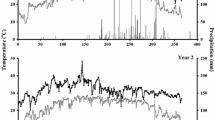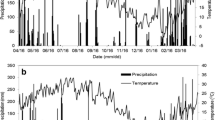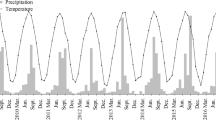Abstract
While essential to food production, nitrogen (N) fertilizers in agricultural ecosystems are also important sources of environmental pollution nationally and globally. The environmental impact of three N fertilization levels (30, 60, and 90 kg ha−1) plus a non-N control (0 kg ha−1) in growing three rice cultivars (cv. Hashemi, cv. Alikazemi, and cv. Khazar) were assessed for 2 years in northern Iran, with the methodology of the life cycle assessment (LCA). The impact categories evaluated in this study were global warming, acidification, terrestrial eutrophication, and depletion of fossil, phosphate, and potassium resources. Over cultivars, no use of N fertilizer provided the lowest grain yield (2194 kg ha−1), whereas the N rates of 60 and 90 kg ha−1 increased grain yield by 52.9 and 66.9%, respectively. Over N rates, cv. Khazar produced the highest grain yield (3415 kg ha−1) and cv. Hashemi the lowest (2663 kg ha−1). On-farm (foreground) emissions were higher than off-farm (background) emissions in most impact categories. The maximum value of environmental index (1.33) was observed for cv. Hashemi with 90 kg N ha−1, while the minimum value (0.38) was observed for cv. Khazar without N fertilization. Moreover, cv. Khazar showed the lowest resource depletion index (0.44) with 90 kg N ha−1, whereas cv. Hashemi with no use of N showed the maximum value (0.96). Over cultivars, high N rates imposed drastic impact to the categories acidification and terrestrial eutrophication. However, selection of high-yielding cultivars significantly alleviated the impact to most categories. Fertilization that enables optimal yields, in accordance with the nutrient requirements of crops, ensures the most efficient land use and sustainable rice production.



Similar content being viewed by others
References
Abeliotis K, Detsis V, Pappia C (2013) Life cycle assessment of bean production in the Prespa National Park. Greece. J Clean Prod 41:89–96
Artacho P, Bonomelli C, Meza F (2009) Nitrogen application in irrigated rice grown in mediterranean conditions: effects on grain yield, dry matter production, nitrogen uptake, and nitrogen use efficiency. J Plant Nutr 32:1574–1593
Asman WAH (1992) Ammonia emissions for Europe. Report no. 228471008 for National Institute of Public Health and Environmental Protection, Bilthoven, Netherlands
Bacenetti J, Fusi A, Negri M, Fiala M, Bocchi S (2016) Organic production systems: sustainability assessment of rice in Italy. Agric Ecosyst Environ 225:33–44
Bharali A, Baruah KK, Gogoi N (2017) Methane emission from irrigated rice ecosystem: relationship with carbon fixation, partitioning and soil carbon storage. Paddy Water Environ 15:221–236
Boateng KK, Obeng GY, Mensah E (2017) Rice cultivation and greenhouse gas emissions: a review and conceptual framework with reference to Ghana. Agriculture 7, 7
Bouman BAM, Humphreys E, Tuong TP, Barker R (2007) Rice and water. Adv Agron 92:187–237
Bouwman AF, Lee DS, Asman WAH, Dentener FJ, Van Der Hoek KW, Olivier JGJ (1997) A global high-resolution emission inventory for ammonia. Global Biochem Cycles 11:561–587
Brentrup F, Küsters J, Lammel J, Kuhlmann H (2000) Methods to estimate on-field nitrogen emissions from crop production as an input to LCA studies in the agricultural sector. Int J Life Cycle Assess 5:349–357
Brentrup F, Küsters J, Kuhlmann H, Lammel J (2004a) Environmental impact assessment of agricultural production systems using the life cycle assessment methodology: I. Theoretical concept of a LCA method tailored to crop production. Eur J Agron 20:247–264
Brentrup F, Küsters J, Lammel J, Barraclough P, Kuhlmann H (2004b) Environmental impact assessment of agricultural production systems using the life cycle assessment (LCA) methodology II. The application to N fertilizer use in winter wheat production systems. Eur J Agron 20:265–279
Cassman K, Peng S, Olk D, Ladha J, Reichardt W, Dobermann A, Singh U (1998) Opportunities for increased nitrogen-use efficiency from improved resource management in irrigated rice systems. Field Crops Res 56:7–39
Charles R, Jolliet O, Gaillard G, Pellet D (2006) Environmental analysis of intensity level in wheat crop production using life cycle assessment. Agric Ecosyst Environ 113:216–225
Conry MJ (1995) Comparisons of early, normal and late sowing at three rates of nitrogen on the yield, grain nitrogen and screenings content of Blenheim spring malting barley in Ireland. J Agric Sci 125:183–188
CPM (2007) SPINE@CPM database. Competence center in environmental assessment of product and material systems (CPM). Chalmers University of Technology, Gothenburg
Dehghani H (2007) Guide to air quality, principles of meteorology and air pollution. Publications of Ghashie, Tehran (in Persian)
Dobermann A, Witt C, Abdulrachman S, Gines H, Nagarajan R, Son T, Tan P, Wang G, Chien N, Thoa V, Phung C, Stalin P, Muthukrishnan P, Ravi V, Babu M, Simbahan G, Adviento M (2003) Soil fertility and indigenous nutrient supply in irrigated rice domains of Asia. Agron J 95:913–923
Dorneanu M (2017) Intensive farming versus-agriculture environmentally sustainable. Quality - Access to Success 18:195–197
Energy Balance Sheet (2008) Available at http://www.moe.gov.ir/ (in Persian)
Environdec (2016) Product category classification: UN CPC 011, 014, 017, 019–arable crops, p. 1–26
Fageria NK, Baligar VC (2001) Lowland rice response to nitrogen fertilization. Commun Soil Sci Plant Anal 32:1405–1429
Fageria NK, Baligar VC (2003) Methodology for evaluation of lowland rice genotypes for nitrogen use efficiency. J Plant Nutr 26:1315–1333
Fageria NK, Baligar VC, Jones CA (1997) Growth and mineral nutrition of field crops, 2nd edn. Marcel Dekker, New York
Fallahpour F, Aminghafouri A, Ghalegolab-Behbahani A, Bannayan M (2012) The environmental impact assessment of wheat and barley production by using life cycle assessment (LCA) methodology. Environ Dev Sustain 14:979–992
Fusi A, Bacenetti J, González-García S, Vercesi A, Bocchi S, Fiala M (2014) Environmental profile of paddy rice cultivation with different straw management. Sci Total Environ 494-495:119–128
Fusi A, González-García S, Moreira MT, Fiala M, Bacenetti J (2017) Rice fertilised with urban sewage sludge and possible mitigation strategies: an environmental assessment. J Clean Prod 140:914–923
Gasol CM, Gabarrell X, Anton A, Rigola M, Carrasco J, Ciria P et al (2007) Life cycle assessment of a Brassica carinata bioenergy cropping system in southern Europe. Biomass Bioenergy 31:543–555
Goebes MD, Strader R, Davidson C (2003) An ammonia emission inventory for fertilizer application in the United States. Atm Environ 37:2539–2550
Huo Z-Y, Gu H-Y, Ma Q, Yang X, Li M, Li G-Y, Dai Q-G, Xu K, Wei H-Y, Gao H, Lu Y, Zhang H-C (2012) Differences of nitrogen absorption and utilization in rice varieties with different productivity levels. Acta Agron Sinica 38:2061–2068
Inthapanya P, Sipaseuth Sihavong P, Sihathep V, Chanphengsay M, Fukai S et al (2000) Genotype differences in nutrient uptake and utilization for grain yield production of rainfed lowland rice under fertilized and non-fertilized conditions. Field Crops Res 65:57–68
IPCC (2006) Guidelines for National Greenhouse Gas Inventories. National Greenhouse Gas Inventories Programme, Institute for Global Environmental Strategies (IGES), Hayama, Japan
Iriarte A, Rieradevall J, Gabarrell X (2010) Life cycle assessment of sunflower and rapeseed as energy crops under Chilean conditions. J Clean Prod 18:336–345
ISO 14040 (2006) Environmental management – Life Cycle Assessment – Requirements and guidelines. International Organization for Standardization
Jiang Y, Van Groenigen KJ, Huang S, Hungate BA, Van Kessel C, Hu S et al (2017) Higher yields and lower methane emissions with new rice cultivars. Glob Chang Biol 23:4728–4738
Khanali M, Movahedi M, Yousefi M, Jahangiri S, Khoshnevisan B (2016) Investigating energy balance and carbon footprint in saffron cultivation – a case study in Iran. J Clean Prod 115:162–171
Khush G (2005) What it will take to feed 5.0 billion rice consumers in 2030. Plant Mol Biol 59:1–6
Koutroubas SD, Ntanos DA (2003) Genotypic differences for grain yield and nitrogen utilization in Indica and Japonica rice under Mediterranean conditions. Field Crops Res 83:251–260
Mirhaji H, Khojastehpour M, Abbaspour-Fard MH (2013) Environmental effects of wheat production in Marvdasht region. J Nat Environ 66:223–232
Nemecek T, Elie OH, Dubois D, Gaillard G, Schaller B, Chervet A (2011) Life cycle assessment of Swiss farming systems: II. Extensive and intensive production. Agric Syst 104:233–245
Nikkhah A, Khojastehpour A, Emadi B, Taheri-Rad AR, Khorramdel S (2015) Environmental impacts of peanut production system using life cycle assessment methodology. J Clean Prod 92:84–90
Nikkhah A, Emadi B, Soltanali H, Firouzi S, Rosentrater K, Allahyari MS (2016) Integration of life cycle assessment and cobb-Douglas modeling for the environmental assessment of kiwifruit in Iran. J Clean Prod 137:843–849
Ntanos DA, Koutroubas SD (2002) Dry matter and N accumulation and translocation for Indica and Japonica rice under Mediterranean conditions. Field Crops Res 74:93–101
Quanbao Y, Hongcheng Z, Haiyan W, Ying Z, Benfo W, Ke X, Zhongyang H, Qigen D, Ke X (2007) Effects of nitrogen fertilizer on nitrogen use efficiency and yield of rice under different soil conditions. Agric China 1:30–36
Renouf MA, Wegener MK, Nielsen LK (2008) An environmental life cycle assessment comparing Australian sugarcane with US corn and UK sugar beet as producers of sugars for fermentation. Biomass Bioenergy 32:1144–1155
Roy P, Shimizu N, Kimura T (2005) Life cycle inventory analysis of rice produced by local processes. J Japanese Soc Agric Machin 67:61–67
Signor D, Cerri CEP (2013) Nitrous oxide emissions in agricultural soils: a review. Pesq Agropec Trop 43:322–338
Singh B, Singh Y, Khind CS, Meelu OP (1991) Leaching losses of urea-N applied to permeable soils under lowland rice. Fert Res 28:179–184
Singh B, Singh Y, Sekhon GS (1995) Fertilizer-N use efficiency and nitrate pollution of groundwater in developing countries. J Contam Hydrol 20:167–184
Snyder CS, Bruulsema TW, Jensen TL, Fixen PE (2009) Review of greenhouse gas emissions from crop production systems and fertilizer management effects. Agric Ecosyst Environ 133:247–266
Soltanali H, Emadi B, Rohani A, Khojastehpour M, Nikkhah A (2015) Life cycle assessment modeling of milk production in Iran. Inform Process Agric 2:101–108
Soltani A, Rajabi MH, Zeinali E, Soltani E (2010) Evaluation of environmental impact of crop production using LCA: wheat in Gorgan. Elect J Crop Prod 3:201–218
Taheri-Rad AR, Nikkhah A, Khojastehpour M, Nourozieh S (2015) Assessing GHG emissions, and energy and economic analysis of cotton production in the Golestan province. J Agric Machin 5:428–445
Tzilivakis J, Warner DJ, May M, Lewis KA, Jaggard K (2005) An assessment of the energy inputs and greenhouse gas emissions in sugar beet (Beta vulgaris) production in the UK. Agric Syst 8:101–119
Van der Hoek KW (1998) Estimating ammonia mission factors in Europe: summary of the work of the UNECE ammonia expert panel. Atm Environ 32:315–316
Van der Werf HMG, Turunen L (2008) The environmental impacts of the production of hemp and flax textile yarn. Ind Crop Prod 27:1–10
Wang M, Wu W, Liu W, Bao Y (2007) Life cycle assessment of the winter wheat-summer maize production system on the North China plain. Int J Sustain Dev World Ecol 14:400–407
Wu L, Yuan S, Huang L et al (2016) Physiological mechanisms underlying the high-grain yield and high-nitrogen use efficiency of elite rice varieties under a low rate of nitrogen application in China. Front Plant Sci 7:1024
Author information
Authors and Affiliations
Corresponding author
Additional information
Responsible editor: Philippe Garrigues
Rights and permissions
About this article
Cite this article
Tayefeh, M., Sadeghi, S.M., Noorhosseini, S.A. et al. Environmental impact of rice production based on nitrogen fertilizer use. Environ Sci Pollut Res 25, 15885–15895 (2018). https://doi.org/10.1007/s11356-018-1788-6
Received:
Accepted:
Published:
Issue Date:
DOI: https://doi.org/10.1007/s11356-018-1788-6




